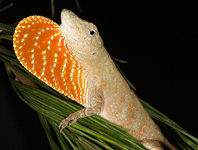Abstract
We describe the new species Anolis peucephilus sp. nov. from the Pacific versant of southern Mexico. Anolis peucephilus differs from all congeners by having a combination of (1) smooth ventral scales; (2) usually a patch of three greatly enlarged supraocular scales; (3) extremely short hind legs, longest toe of adpressed hind leg reaching to a point between levels of axilla and ear opening, ratio shank length/snout-vent length 0.18–0.21; (4) circumnasal usually in contact with first supralabial; and (5) a large yellowish orange dewlap in males and a very small to small white dewlap in females. In external morphology, A. peucephilus is most similar to A. omiltemanus from which it differs by having even shorter hind legs with the longest toe of adpressed hind leg reaching to a point between levels of axilla and ear opening (versus usually to ear opening, occasionally to slightly beyond ear opening or to a point between shoulder and ear opening in A. omiltemanus), a slightly larger dewlap in females, to 64 mm2 (versus to 41 mm2 in A. omiltemanus), the circumnasal usually in contact with the first supralabial (versus those scales separated by the presence of a subnasal in A. omiltemanus), and 4–6 internasal scales in the new species (versus usually 6–7 in A. omiltemanus). Furthermore, A. peucephilus differs from A. omiltemanus in hemipenial morphology (no finger-like processus on asulcate side in A. peucephilus versus such a processus present in A. omiltemanus). Also, in a preliminary molecular genetic analysis of the mitochondrial CO1 gene fragment, A. peucephilus has a genetic distance of 11.5% from A. omiltemanus. Anolis peucephilus was collected at night while the lizards were sleeping in pine trees, 2–10 m above the ground.

